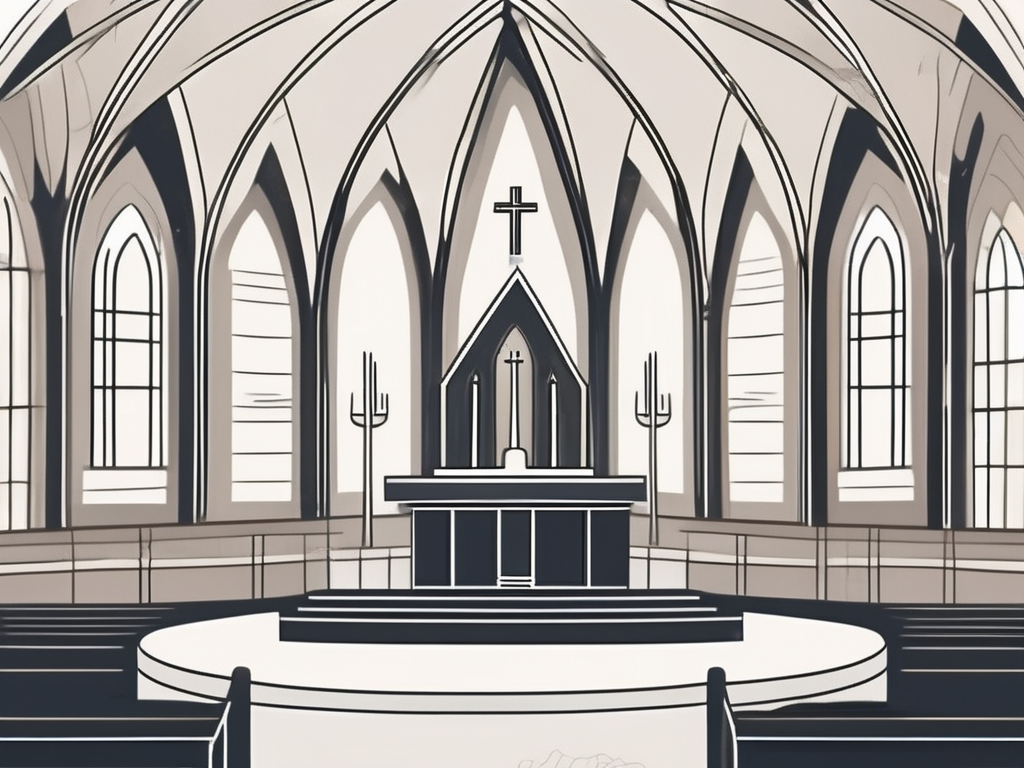Christianity, one of the world’s major religions, holds worship as a central practice within its belief system. From humble home churches to grand cathedrals, Christians gather in various places to worship and connect with their faith. In this article, we explore the concept of worship in Christianity, the role of the church as a place of worship, the different types of Christian worship places, the significance of sacred objects in worship, and the worship practices across different Christian denominations.
Understanding the Concept of Worship in Christianity
Worship is an essential part of the Christian faith, as it allows believers to express their devotion to God. It goes beyond rituals and ceremonies; it is a deeply personal and communal experience. Christian worship involves a wide range of practices, such as prayer, singing hymns, reading scripture, and participating in sacraments like baptism and communion.
Worship in Christianity is not limited to a specific time or place. It can take place anywhere, as believers believe that God is present everywhere. However, certain locations hold a special significance in the Christian tradition.
One such location is the church, which is considered a sacred space where believers gather to worship. The church is not just a building; it is a symbol of the community of believers and a place where they can come together to worship and seek spiritual guidance. The architecture of the church often reflects the beliefs and values of the Christian faith, with features such as stained glass windows, high ceilings, and intricate artwork.
The Biblical Basis for Christian Worship
The Bible, the holy text of Christianity, provides a foundation for Christian worship. In both the Old and New Testaments, we find examples of people coming together to worship God. The Psalms, for instance, contain songs of praise and worship. These songs express a range of emotions, from joy and gratitude to sorrow and lamentation, reflecting the diverse experiences of believers throughout history.
In the New Testament, Jesus also emphasized the importance of worship, instructing his followers to gather together in his name to worship God. He said, “For where two or three gather in my name, there am I with them” (Matthew 18:20, NIV). This highlights the significance of communal worship and the presence of God in the midst of believers.
The Significance of Worship in Christian Life
Christian worship plays a vital role in the lives of believers. It serves as a means of expressing gratitude, seeking guidance, finding comfort, and fostering spiritual growth. Through worship, Christians connect with God and with each other, building a sense of community and unity.
Moreover, worship is an opportunity for believers to deepen their relationship with God, to reflect on their faith, and to receive spiritual nourishment. It is not just a duty but a joyful response to God’s love and grace. In worship, believers can experience a sense of awe and wonder, as they encounter the presence of God in a tangible way.
Furthermore, worship is not limited to formal gatherings or church services. It can be a part of everyday life, as believers strive to live out their faith in all aspects of their lives. Acts of kindness, service to others, and acts of worship in solitude are all expressions of devotion to God.
In conclusion, worship is a central aspect of the Christian faith, encompassing a variety of practices and experiences. It is a way for believers to express their devotion, connect with God and with each other, and deepen their relationship with Him. Whether in a church building or in the quiet moments of daily life, worship is a powerful and transformative experience for Christians.
The Church as a Place of Worship
For many Christians, the church serves as a central place of worship. It is a physical space where believers gather as a community to engage in worship and receive spiritual teachings. The church’s role extends beyond worship; it also serves as a place for fellowship, education, and outreach.
Within the walls of a church, believers find solace and a sense of belonging. The atmosphere is filled with a palpable sense of devotion and reverence. The pews, arranged in neat rows, offer a place for congregants to sit and reflect. The soft glow of candlelight adds to the sacred ambiance, casting a warm and comforting light throughout the space.
As the church bell tolls, signaling the beginning of a service, the sound reverberates through the air, calling the faithful to gather. The air is filled with anticipation as worshippers enter the sanctuary, their footsteps echoing softly against the polished stone floors.
The Historical Evolution of the Church
The church has evolved throughout history, adapting to different cultural influences and societal changes. From the simplicity of early house churches to the grandeur of medieval cathedrals, the architecture, rituals, and practices of Christian worship have varied over time.
In the early centuries of Christianity, believers often met in homes or secret locations due to persecution. These intimate gatherings allowed for a close-knit community, where individuals could openly express their faith without fear of retribution. The walls of these humble abodes became witnesses to the fervent prayers and heartfelt worship of the early Christians.
As Christianity became more accepted, dedicated church buildings were constructed, embodying the values and beliefs of the faith. These architectural marvels became symbols of the enduring strength and resilience of the Christian community. Each stone laid, each stained glass window meticulously crafted, was a testament to the devotion and love of the believers.
The Architectural Elements of a Christian Church
A Christian church typically features distinctive architectural elements intended to enhance the worship experience. Elements such as stained glass windows, vaulted ceilings, and ornate decorations create an ambiance that inspires reverence and awe. The soft, ethereal light that filters through the stained glass windows paints vibrant hues on the walls, casting a mesmerizing kaleidoscope of colors.
The vaulted ceilings, reaching towards the heavens, create a sense of vastness and grandeur. The acoustics of the space amplify the sound of hymns and prayers, filling the air with a celestial melody that resonates deep within the souls of the worshippers.
The layout of the church, with its nave, altar, and transepts, reflects the central aspects of Christian worship. The nave, the central part of the church, represents the gathering of the faithful. It is here that the congregation comes together to listen to sermons, sing hymns, and offer prayers.
The altar, positioned at the front of the church, serves as the focal point of worship. It is a sacred space where the Eucharist is celebrated, symbolizing the body and blood of Christ. The transepts, extending from the nave, form the shape of a cross, representing the crucifixion of Jesus and serving as a reminder of his sacrifice.
Furthermore, the presence of religious symbols and artwork in churches, such as statues and paintings depicting biblical figures and events, adds to the spiritual atmosphere and aids in storytelling. These visual representations serve as a visual catechism, teaching and inspiring the faithful through their beauty and symbolism.
Different Types of Christian Worship Places
Christian worship is not confined to traditional churches alone. There are various types of worship places that cater to different preferences and needs of believers. Let’s explore a few of them:
Cathedrals: The Grandeur of Christian Worship
Cathedrals, with their towering spires and intricate architecture, are awe-inspiring places of Christian worship. These grand structures often serve as the primary church in a diocese and are associated with significant historical and religious events. Cathedrals provide a sense of majesty, inviting worshippers to experience a powerful connection with God.
When you step into a cathedral, you are immediately struck by the sheer scale and beauty of the space. The high ceilings seem to reach up to the heavens, creating a sense of reverence and awe. The stained glass windows, with their vibrant colors and intricate designs, tell stories from the Bible, bringing the scriptures to life. The echoes of hymns and prayers reverberate through the grand halls, creating a sacred atmosphere that envelops worshippers in a sense of transcendence.
Many cathedrals are adorned with ornate sculptures and artwork, depicting scenes from the life of Jesus and other biblical figures. These intricate details serve as a visual representation of the faith and devotion of the worshippers. The grandeur of cathedrals not only inspires a deep connection with God but also fosters a sense of unity among believers, as they gather together in this sacred space to worship and seek spiritual guidance.
Chapels: Intimate Spaces for Worship
Chapels offer a more intimate and peaceful setting for Christian worship. They are usually smaller than traditional churches and are found in locations such as hospitals, schools, and private homes. Chapels provide a quiet retreat for individual reflection and small group gatherings, fostering a sense of closeness with God.
When you enter a chapel, you are greeted by a serene and tranquil atmosphere. The soft lighting and simple decor create a sense of calm, allowing worshippers to focus their thoughts and prayers. The smaller size of chapels promotes a more personal and intimate worship experience, where individuals can connect with God on a deeper level.
Chapels often have a designated area for prayer, with comfortable seating or kneelers for worshippers to use. The walls may be adorned with religious artwork or scriptures, serving as visual reminders of the faith. Some chapels also have a small altar or religious symbols, such as a cross or an icon, as a focal point for worship. The peaceful ambiance of chapels makes them ideal places for quiet contemplation, meditation, and seeking solace in times of need.
Home Churches: Personal and Community Worship
In recent years, home churches have grown in popularity. These are informal gatherings of believers who meet in private residences to worship together. Home churches provide a more relaxed and familiar environment for worship, promoting a sense of community and shared spirituality.
Home churches offer a unique and personal approach to Christian worship. They are often led by a member of the community, rather than a formal religious leader, creating a more inclusive and participatory experience. The setting of a home church allows for open discussions, shared meals, and a sense of belonging among the worshippers.
When you attend a home church, you are welcomed into someone’s living room or backyard, creating a warm and inviting atmosphere. The worship space may be adorned with simple decorations, such as candles or flowers, creating a sense of sacredness. The informality of home churches encourages worshippers to express their faith in their own unique ways, whether through singing, praying, or sharing personal testimonies.
Home churches often prioritize building strong relationships within the community, fostering a sense of support and care for one another. They provide a space where believers can grow spiritually together, share their joys and struggles, and find encouragement in their faith journey. Home churches exemplify the idea that worship is not confined to a physical building but can happen anywhere believers gather in the name of God.
The Role of Sacred Objects in Christian Worship
In Christian worship, sacred objects hold deep symbolism and carry spiritual significance. They serve as visual reminders of the faith and help believers focus their thoughts and prayers. Two prominent sacred objects in Christianity are:
The Cross: A Central Symbol in Christian Worship
The cross, representing Jesus’ crucifixion and resurrection, is a powerful symbol in Christian worship. It serves as a reminder of God’s love and sacrifice, encouraging believers to embrace their faith and aspire to live according to Christ’s teachings. The presence of the cross in churches and personal spaces provides a focal point for contemplation and devotion.
The Altar: The Heart of Christian Worship
The altar holds a central place in Christian worship, representing the presence of God. It is where various rituals and sacraments take place, such as the Eucharist or Holy Communion. The altar serves as a focal point for worship, signifying the sacred space where believers encounter the divine.
The Worship Practices in Different Christian Denominations
Christianity encompasses a wide range of denominations, each with its unique worship practices. While the core elements of worship, such as prayer and scripture, remain consistent across denominations, there are variations in rituals and traditions. Let’s briefly explore worship practices in a few major Christian denominations:
Worship in Catholicism
Catholic worship is characterized by its rich liturgical traditions and sacraments. The Eucharist, also known as Mass, holds central importance in Catholic worship. The use of incense, hymns, and chants contributes to the solemn and reverential atmosphere in Catholic churches.
Worship in Protestantism
Protestant worship reflects diversity, with different denominations following various styles and approaches. Some emphasize the use of contemporary music and informal settings, prioritizing personal connection and engagement with God. Others maintain more formal traditions, incorporating liturgical elements and hymns.
Worship in Orthodox Christianity
Orthodox Christian worship places great emphasis on continuity with early Christian tradition. Liturgical services in Orthodox churches involve ancient hymns, chanted prayers, and detailed rituals. The visuals, such as icons and iconostases, play a significant role in facilitating worship and fostering a sense of sacredness.
In conclusion, the place of worship for Christianity is not confined to a single location but extends to various settings where believers gather to express their devotion and connect with God. Whether in grand cathedrals or humble home churches, worship forms an essential and integral part of the Christian faith, fostering spiritual growth, community, and deeper communion with the divine.












